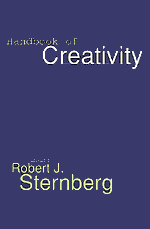Book contents
- Frontmatter
- Contents
- List of Contributors
- Preface
- Handbook of Creativity
- PART I INTRODUCTION
- PART II METHODS FOR STUDYING CREATIVITY
- PART III ORIGINS OF CREATIVITY
- PART IV CREATIVITY, THE SELF, AND THE ENVIRONMENT
- PART V SPECIAL TOPICS IN CREATIVITY
- 17 Creativity Across Cultures
- 18 Computer Models of Creativity
- 19 Organizational Creativity
- 20 Enhancing Creativity
- 21 Prodigies and Creativity
- PART VI CONCLUSION
- Author Index
- Subject Index
18 - Computer Models of Creativity
Published online by Cambridge University Press: 05 June 2014
- Frontmatter
- Contents
- List of Contributors
- Preface
- Handbook of Creativity
- PART I INTRODUCTION
- PART II METHODS FOR STUDYING CREATIVITY
- PART III ORIGINS OF CREATIVITY
- PART IV CREATIVITY, THE SELF, AND THE ENVIRONMENT
- PART V SPECIAL TOPICS IN CREATIVITY
- 17 Creativity Across Cultures
- 18 Computer Models of Creativity
- 19 Organizational Creativity
- 20 Enhancing Creativity
- 21 Prodigies and Creativity
- PART VI CONCLUSION
- Author Index
- Subject Index
Summary
CREATIVITY AND COMPUTERS
Computational psychology uses ideas from artificial intelligence (AI) to formulate its theories about how the mind works, and sees AI models as tests of the coherence and power of those theories. In addition, it compares empirical evidence about human psychology with the performance and internal processing of the models. Among the many psychologically motivated AI models, some aim to throw light on creativity.
Creativity is the generation of ideas that are both novel and valuable. Ideas, here, is intended in a very broad sense to include concepts, designs, theories, melodies, paintings, sculptures, and so on. The novelty may be defined with reference either to the previous ideas of the individual concerned or to the whole of human history. The former definition concerns P-creativity (P for psychological), the latter H-creativity (H for historical) (Boden, 1990, chap. 3). H-creativity presupposes P-creativity, for if someone has a historically novel idea, then it must be new to that person as well as to others.
The idea may not be recognized immediately (even by its originator) as valuable, or even as new. Historians of science and of art have described many self-doubts, and many more social disputes, over what are now regarded as important creative insights. Even something so apparently straightforward as the discovery of dinosaurs was negotiated by the relevant (international) scientific peer group for many years before agreement could be reached on just what, if anything, had been discovered (Schaffer, 1994).
- Type
- Chapter
- Information
- Handbook of Creativity , pp. 351 - 372Publisher: Cambridge University PressPrint publication year: 1998
- 18
- Cited by



